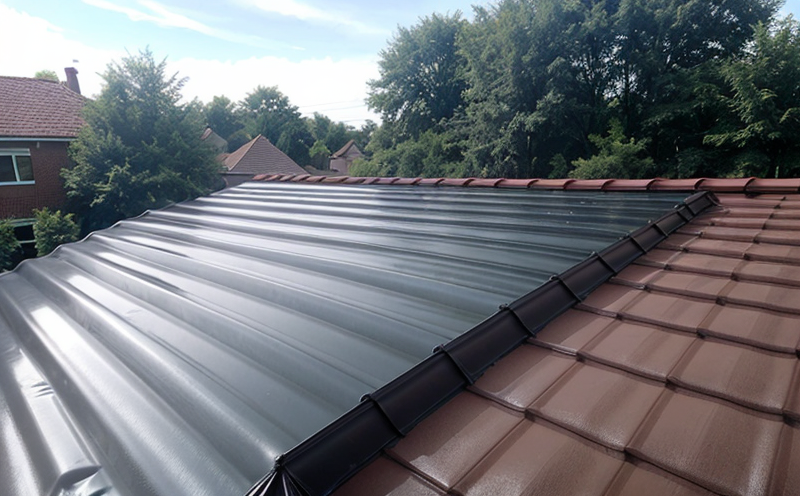ASTM D5729 Adhesion Strength Testing of Membranes
The ASTM D5729 standard is a critical method used to assess the adhesion strength between waterproofing membranes and concrete substrates. This test ensures that the membrane adheres effectively, which is essential for preventing water intrusion into structures, thus extending their lifespan and ensuring structural integrity.
ASTM D5729 specifies a cross-head speed of 10 mm/min during tensile testing to measure the adhesion strength. The test involves preparing a sample that includes both the concrete substrate and the waterproofing membrane bonded together. The sample is then subjected to uniaxial tension until failure occurs, measuring the force required to separate the two materials.
The results of this test are crucial for quality managers as it helps them ensure that the chosen membranes meet industry standards and can withstand real-world conditions. Compliance officers use these tests to verify adherence to building codes and regulations. R&D engineers rely on ASTM D5729 to develop new membrane formulations that offer superior adhesion properties, while procurement teams use this data to select reliable suppliers.
The test is particularly important in environments where waterproofing is critical, such as commercial buildings, residential complexes, and infrastructure projects like bridges and tunnels. In these settings, the failure of a membrane can lead to costly repairs, water damage, and potential safety hazards. Thus, ASTM D5729 testing plays a vital role in ensuring that the materials used are robust and reliable.
The process involves precise specimen preparation, where samples must be cut to specific dimensions and shapes as specified by ASTM guidelines. The specimens are then bonded using a suitable adhesive before being tested under tension. This meticulous approach ensures accurate and repeatable results, which is crucial for quality assurance in the construction industry.
Understanding the parameters of this test is essential for those involved in roofing and waterproofing projects. For instance, knowing that the cross-head speed must be 10 mm/min helps in setting up the testing equipment correctly. The force at failure indicates the bond strength between the membrane and the substrate, which can vary based on factors such as the type of adhesive used, surface roughness, and environmental conditions.
In summary, ASTM D5729 adhesion strength testing is a cornerstone for ensuring that waterproofing membranes are reliable and effective in preventing water infiltration. By adhering to this standard, construction professionals can enhance the durability and safety of buildings and infrastructure projects across various sectors.
Why It Matters
The importance of ASTM D5729 adhesion strength testing cannot be overstated in terms of ensuring structural integrity and preventing water intrusion. Properly bonded membranes are essential for the longevity of structures, reducing maintenance costs and potential repairs.
In commercial buildings, where foot traffic and environmental exposure can lead to membrane degradation over time, ASTM D5729 ensures that the waterproofing system remains effective. In residential complexes, this test is crucial for ensuring that each home’s roofing and waterproofing systems are robust against external elements like rain and snow.
For infrastructure projects such as bridges and tunnels, where water ingress can compromise structural stability, ASTM D5729 testing provides a critical measure of the effectiveness of the waterproofing membranes. This ensures that these vital structures remain safe and functional for extended periods.
The test also plays a role in sustainability by promoting the use of materials and techniques that enhance the durability of buildings and infrastructure. By adhering to ASTM standards, construction professionals contribute to more sustainable practices, reducing the environmental impact of building failures due to waterproofing issues.
Moreover, compliance with ASTM D5729 helps in maintaining regulatory standards and industry best practices. This ensures that all participants in the roofing and waterproofing sector are working towards the same high-quality benchmarks, which is essential for maintaining consumer trust and confidence.
Why Choose This Test
- Ensures adherence between membranes and substrates to prevent water intrusion.
- Maintains regulatory compliance with industry standards.
- Enhances the durability and safety of buildings and infrastructure projects.
- Reduces maintenance costs and potential repairs by ensuring effective waterproofing.
- Promotes sustainable practices by extending the lifespan of structures.
- Guarantees that all participants in the roofing sector adhere to the same high-quality benchmarks.
- Provides robust data for R&D engineers to develop new membrane formulations.
Customer Impact and Satisfaction
The impact of ASTM D5729 adhesion strength testing is profound, with direct benefits for customers in terms of enhanced product reliability and safety. By ensuring that membranes adhere effectively, this test reduces the risk of water infiltration, which can lead to structural damage and increased maintenance costs.
Customers involved in roofing and waterproofing projects benefit from ASTM D5729 by having peace of mind knowing that their structures are protected against environmental elements. This leads to higher customer satisfaction as they can trust that the materials used meet industry standards and are reliable.
The test also supports long-term sustainability goals, ensuring that buildings and infrastructure remain functional for longer periods without costly repairs. This not only enhances customer confidence but also contributes to a more sustainable built environment.
For quality managers and compliance officers, adhering to ASTM D5729 ensures that they are meeting industry best practices and regulatory requirements. This aligns with their goals of maintaining high standards and ensuring product reliability, ultimately leading to increased customer satisfaction.
R&D engineers who use ASTM D5729 data can innovate new membrane formulations that offer even better adhesion properties. This not only enhances the performance of products but also sets a benchmark for industry innovation, contributing to long-term customer loyalty and satisfaction.





